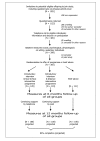The ProActive trial protocol - a randomised controlled trial of the efficacy of a family-based, domiciliary intervention programme to increase physical activity among individuals at high risk of diabetes [ISRCTN61323766]
- PMID: 15491494
- PMCID: PMC526256
- DOI: 10.1186/1471-2458-4-48
The ProActive trial protocol - a randomised controlled trial of the efficacy of a family-based, domiciliary intervention programme to increase physical activity among individuals at high risk of diabetes [ISRCTN61323766]
Abstract
Background: Increasing prevalence of obesity and disorders associated with sedentary living constitute a major global public health problem. While previous evaluations of interventions to increase physical activity have involved communities or individuals with established disease, less attention has been given to interventions for individuals at risk of disease.
Methods/design: ProActive aims to evaluate the efficacy of a theoretical, evidence- and family-based intervention programme to increase physical activity in a sedentary population, defined as being at-risk through having a parental family history of diabetes. Primary care diabetes or family history registers were used to recruit 365 individuals aged 30-50 years, screened for activity level. Participants were assigned by central randomisation to three intervention programmes: brief written advice (comparison group), or a psychologically based behavioural change programme, delivered either by telephone (distance group) or face-to-face in the family home over one year. The protocol-driven intervention programme is delivered by trained facilitators, and aims to support increases in physical activity through the introduction and facilitation of a range of self-regulatory skills (e.g. goal setting). The primary outcome is daytime energy expenditure and its ratio to resting energy expenditure, measured at baseline and one year using individually calibrated heart rate monitoring. Secondary measures include self-report of individual and family activity, psychological mediators of behaviour change, physiological and biochemical correlates, acceptability, and costs, measured at baseline, six months and one year. The primary intention to treat analysis will compare groups at one-year post randomisation. Estimation of the impact on diabetes incidence will be modelled using data from a parallel ten-year cohort study using similar measures.
Discussion: ProActive is the first efficacy trial of an intervention programme to promote physical activity in a defined high-risk group accessible through primary care. The intervention programme is based on psychological theory and evidence; it introduces and facilitates the use of self-regulatory skills to support behaviour change and maintenance. The trial addresses a range of methodological weaknesses in the field by careful specification and quality assurance of the intervention programme, precise characterisation of participants, year-long follow-up and objective measurement of physical activity. Due to report in 2005, ProActive will provide estimates of the extent to which this approach could assist at-risk groups who could benefit from changes in behaviours affecting health, and inform future pragmatic trials.
Figures
References
-
- Murray CJ, Lopez AD. Global burden of disease. Cambridge, Mass., Harvard University Press; 1996.
-
- Sallis JF, Owen N. Physical activity and behavioural medicine. Thousand Oaks, California, Sage Publications, USA; 1998. (Behavioral Medicine & Health Psychology).
-
- Sargeant LA, Wareham NJ, Khaw KT. Family history of diabetes identifies a group at increased risk for the metabolic consequences of obesity and physical inactivity in EPIC-Norfolk: a population-based study. The European Prospective Investigation into Cancer. Int J Obes Relat Metab Disord. 2000;24:1333–1339. - PubMed
-
- Manson JE, Rimm EB, Stampfer MJ, Colditz GA, Willett WC, Krolewski AS, Rosner B, Hennekens CH, Speizer FE. Physical activity and incidence of non-insulin-dependent diabetes mellitus in women. Lancet. 1991;338:774–778. - PubMed
-
- Hamman RF. Prevention of Type 2 Diabetes. In: WilliamsR, HermanW, KinmonthAL and WarehamNJ, editor. Evidence Base for Diabetes Care. Chichester, Wiley; 2002. pp. 75–176.


